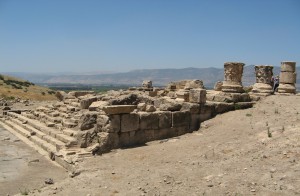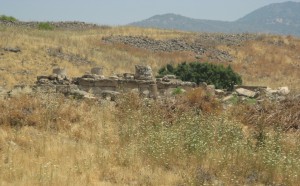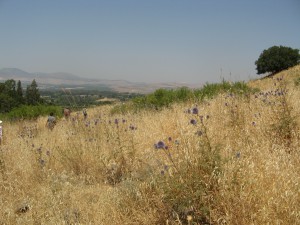As majestically as the ruins at Omrit are positioned, I’m no less struck by the colors of the place: the pristine blue above, the pale gold and burnt green of the hills, the purple of the round, thistly wildflowers scattered about the countryside. The photographs I saw of the site before arriving in Israel prepared me for a duller palette, one in line with my stereotype of an archaeological dig. It’s hard to imagine that a landscape capable of Omrit’s springtime beauty could swallow the temple complex once standing here.
But on Wednesday, the first day of the dig season, our team spent hours clearing newly accumulated earth and rubble from the site’s pavement, which was excavated years ago and has gone untended only since last summer. I was forced to recognize the relentlessness with which even nature at its mildest can upset human labor. In the pavement’s northeast corner we re-uncovered a sizeable inscription, a dedication in Greek by a certain Agrippina to the goddess Echo. Dated to the first century CE, the inscription was roughly carved and presumably filled with bronze lettering that’s now missing.
While raising intriguing possibilities for the original functions of the temple complex, the dedication has also made the ancient human presence here palpable to me, more palpable than even the temple podium and stacked column fragments that preside over the site have. These architectural elements seem at moments to be natural features of the landscape. The writing in stone, on the other hand, cannot but testify to the intellect that produced it. When that writing came to light this week for at least the second time in its history, I was reminded that archaeologists are as much keepers as they are finders of the material links to our past, and I felt truly excited for the excavations our team will undertake here this month.



